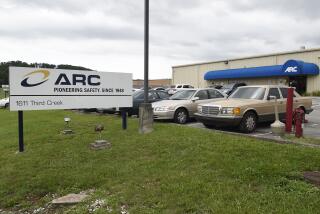Jeep’s New Mission: Ride to the Rescue, Rubicon or Not
- Share via
The venerable Jeep brand is getting a new logo and a revised mission this week. A new advertising campaign will portray Jeeps and their owners not so much as tough off-roaders but as highway helpers, ready to ride to the rescue in conditions other vehicles can’t handle.
DaimlerChrysler says it no longer will adhere to the old dictum that, to be a Jeep, it must be able to traverse Northern California’s Rubicon Trail, renowned in the off-roading world for its nonstop ruggedness. Ironically, the new approach comes just after Jeep launched the Wrangler Rubicon, beefed up at the factory with much of the stuff hard-core off-roaders add on their own and priced well below the cost of buying a new Wrangler and beefing-up in the aftermarket.
The new logo plays on Jeep’s wartime heritage and features a silhouette of the original folding windshield, grille and headlamps on an Army green background.
Jeep, which once had the off-roading crowd to itself, remains a leader in the segment but is facing stiff competition from other brands that are flooding the market with four-wheel-drive sport utility vehicles.
The advertising pitch, aimed at helping to double sales over the next decade to 800,000 vehicles a year, will present Jeep as a maker of real off-road vehicles driven by thoughtful, patriotic buyers.
“It is the noble liberator. It is the authentic American hero,” said Jeff Bell, Chrysler’s vice president of Jeep marketing.
Chrysler Chief Executive Dieter Zetsche and other Chrysler executives have complained that the valuable Jeep brand has not been exploited properly and have said they intend to expand the three-model lineup as soon as possible.
But a company edict--imposed in 1986 by former Chrysler President Bob Lutz, now vice chairman of General Motors--holds that all Jeeps must be capable of traversing the Rubicon Trail near Lake Tahoe, and that has slowed development of new models. Rubicon-ready Jeeps need heavy-duty components that add weight and cost and limit how many parts Jeeps can share with other DaimlerChrysler vehicles.
So Chrysler has decided to shift its emphasis to other measures of Jeep prowess.
The ad campaign will show Jeeps on off-road trails, but they also promote “rescue capability,” a term Bell said would represent the new standard for Jeeps.
He said the additional safety and security that goes into a true off-road vehicle also is important in highway use.
In one ad, three Jeeps plug a hole in a guardrail on a rain-slicked highway just before a car speeds past it. “Jeep owners stop and help others in duress,” Bell said. “Rescue capability is our focus.”
Meanwhile, Jeep has started selling its $24,995 Rubicon in an effort to share in the profits that after-market, off-road shops have been making for years.
Jack Broomall, Jeep’s product development director, estimates that the factory modifications would cost at least $10,000 if purchased separately and added by the owner.
Jeep sells the Rubicon for the same price as the top-of-the-line Wrangler Sahara, but tosses out the stock axels and transfer case in favor of Dana 44 axels front and rear, each with a hydraulic locker that enables the driver to lock the rear axel or the front and rear axels in tandem with the push of a button on the dash.
Stock tires are 31-inch rough terrain rubber, and the Rubicon transfer case is geared down to a 4 to 1 ratio, low enough that the manual transmission models can be maneuvered over the entire Rubicon without using the clutch.
The Wrangler Rubicon also carries Jeep’s seven-year, 70,000-mile limited powertrain warranty on all those beefy parts, something your do-it-yourself conversion can’t match.
Hyundai Misstated Power
In an unusually candid moment for an auto company, Hyundai Motor America said Monday that it had inadvertently misstated the horsepower rating on 1.3 million vehicles in U.S. since 1992, understating the power output of some and overstating it for others.
For most of those, the error was within a 4% tolerance Hyundai officials say is permissible.
But the variance was exceeded in about 400,000 cases, and owners of those vehicles--nearly 20% of the cars and SUVs Hyundai has sold in the U.S. since ‘92--will be offered extended warranties or extended roadside service contracts to make up for the disappointment of learning that their Hyundai has less power than was advertised.
Finbarr O’Neill, president and chief executive of Fountain Valley-based Hyundai Motor America, said the errors were caused by lack of internal processes to communicate technical data between engineering and marketing.
O’Neill said he decided to reveal that the horsepower errors affected 1.3 million vehicles instead of confessing to just the 400,000 most egregious cases “because it is a lot better to come to the market and say we made a mistake, discovered the problem and this is what it is.”
Any damage to Hyundai’s reputation, he said, will be far less than “if we became the company that buries facts like these.”
O’Neill said affected owners and lessees will receive a letter from Hyundai detailing their options.
Those who don’t want to wait, he said, can call Hyundai’s consumer line at (800) 218-9797 or go to www.hyundaistatus.com.






